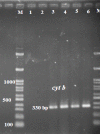Effect of Carum copticum nano-essence against Saprolegnia and Fusarium, and the Use of Multiplex PCR Assay for the Detection of These Organisms in Rainbow trout Oncorhynchus mykiss
- PMID: 34223722
- PMCID: PMC8410186
- DOI: 10.22092/ari.2020.342066.1450
Effect of Carum copticum nano-essence against Saprolegnia and Fusarium, and the Use of Multiplex PCR Assay for the Detection of These Organisms in Rainbow trout Oncorhynchus mykiss
Abstract
This study aimed to investigate the fungal species isolation and confirmation by the Multiplex PCR method in aquatic fish. Evaluation of the inhibitory effect of nano-essential oils of Carum copticum on isolated fungal species was also conducted in this study. The PCR results showed that 3 out of 5 samples were diagnosed with Fusarium solani, and two of them were positive for Saprolegnia. Moreover, in 0.1% of the females' nanoparticles, one peak appeared that showed a particle with an average diameter of 360 nm, and two nanoparticles showed a peak with a mean diameter of 242 nm. The results of minimum inhibitory concentrations (MIC) and minimum fungicidal concentrations (MFC) showed that 0.01% nano essential oil had 0.08 and 0.07 mg/ml MIC values against Fusarium solani and Saprolegnia, respectively. Gram/ml was on the growth of Fusarium solani species. The essential oils of female plants had an MIC of 0.07 in 0.1% essential oil and 0.03 mg/ml in 0.01% essential oil in Saprolegnia. Furthermore, in the case of 0.1% nano essential oil, the results showed the MIC values of 0.04 and 0.03 mg/ml against Fusarium solani and Saprolegnia, respectively. The MFC values of 0.1% nano essential oil were 0.1 and 0.07 mg/ml against Fusarium solani and Saprolegnia,respectively. It was not found on Fusarium and Saprolegnia. Overall, the results of this study using PCR for direct detection showed that 70% and 50% of the samples were Fusarium solani and Saprolegnia positive, respectively; therefore, the PCR was an efficient method for the detection of fungi. According to the results of nano-essential oil (0.1%) of females, this nano-essence had a strong inhibitory effect on Fusarium solani and Saprolegnia.
Keywords: Carum copticum; Fusarium; Multiplex PCR; Nano-essence; Oncorhynchus mykiss; Saprolegnia.
Copyright © 2021, Author(s). Published by Kowsar.
Figures
Similar articles
-
Evaluation of the antifungal activity of Zataria multiflora, Geranium herbarium, and Eucalyptus camaldolensis essential oils on Saprolegnia parasitica-infected rainbow trout (Oncorhynchus mykiss) eggs.Foodborne Pathog Dis. 2012 Jul;9(7):674-9. doi: 10.1089/fpd.2011.1086. Epub 2012 Jun 12. Foodborne Pathog Dis. 2012. PMID: 22690761
-
Characterization and Physical and Biological Properties of Tissue Conditioner Incorporated with Carum copticum L.Biomed Res Int. 2021 Aug 12;2021:5577760. doi: 10.1155/2021/5577760. eCollection 2021. Biomed Res Int. 2021. PMID: 34423036 Free PMC article.
-
Comparative Effects of Carum copticum Essential Oil on Bacterial Growth and Shiga-Toxin Gene Expression of Escherichia coli O157:H7 at Abused Refrigerated Temperatures.Curr Microbiol. 2020 Aug;77(8):1660-1666. doi: 10.1007/s00284-020-01987-4. Epub 2020 Apr 13. Curr Microbiol. 2020. PMID: 32285153
-
Evaluation of antioxidant and antimicrobial activities of essential oils from Carum copticum seed and Ferula assafoetida latex.J Food Sci. 2013 Feb;78(2):T356-61. doi: 10.1111/1750-3841.12020. Epub 2013 Jan 16. J Food Sci. 2013. PMID: 23320824
-
Antioxidant properties and anti-quorum sensing potential of Carum copticum essential oil and phenolics against Chromobacterium violaceum.J Food Sci Technol. 2018 Aug;55(8):2824-2832. doi: 10.1007/s13197-018-3219-6. Epub 2018 May 21. J Food Sci Technol. 2018. PMID: 30065392 Free PMC article. Review.
Cited by
-
Use of Essential Oils in Veterinary Medicine to Combat Bacterial and Fungal Infections.Vet Sci. 2020 Nov 30;7(4):193. doi: 10.3390/vetsci7040193. Vet Sci. 2020. PMID: 33266079 Free PMC article. Review.
References
-
- Chahal K, Dhaiwal K, Kumar A, Kataria D, Singla N. Chemical composition of Trachyspermum ammi L. and its biological properties: A review. J Pharmacogn Phytochem. 2017; 6: 131–140.
-
- Daouk RK, Dagher SM, Sattout EJ. Antifungal Activity of the Essential Oil of Origanum syriacum L. J Food Prot. 1995; 58: 1147–1149. - PubMed
-
- Gevezova M, Tserkova F, Kirilova I, Hubenova T, Zaikov A, Ivanova A, et al. Potential of PCR-based Molecular Diagnostic Methods for Rapid Detection of Bacterial Pathogens Causing Economically Important Diseases in Fishes. Acta Zoologica Bulgarica Supplementum. 2017; 8: 37–40.
-
- Ghiasi M, Khosravi A, Soltani M, Sharifpour I, Binaii M, Ebrahimzadeh Mosavi H, et al. Evaluation of physiological aspects and molecular identification of Saprolegnia isolates from rainbow trout (Oncorhynchus mykiss) and Caspian trout (Salmo trutta caspius) eggs based on RAPD–PCR. Iran Sci Fish J. 2014; 22: 82–92.
MeSH terms
Substances
Supplementary concepts
LinkOut - more resources
Full Text Sources



